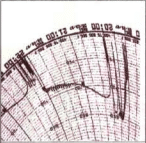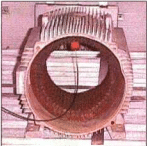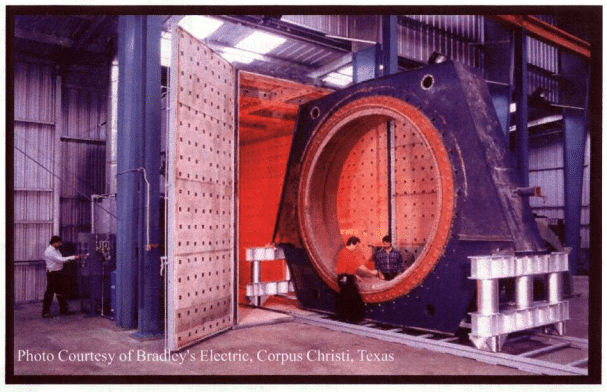
Many electric motor rebuilders are “getting burned” in the process of stripping their motors. You can now meet EASA standards without the headaches of fires, explosions, overheated parts, and excessive cycle times.
No More Core Damage from Overheating
There are two ways in which a motor can exceed setpoint in a burn-off oven:
- The combustion gases from the burner in bottom-fired ovens can overheat the core.
- The combustible varnish or epoxy can burn on the core (exotherm) which may cause the core temperature to exceed oven setpoint.
The Steelman Burn-off Oven eliminates these problems with our patented Top-Down Heating, Part Temperature Control, Venturi Diffuser and Rate-of-Change Control.
You CAN meet EASA standards without sacrificing speed or safety with a Steelman Heat-Cleaning Oven!
WHAT YOU SHOULD KNOW ABOUT CORE LOSS
Core loss occurs when the insulation between the laminations in a stator core breaks down due to mechanical damage or excessive temperature. The way to avoid mechanical damage is to use a heat-cleaning oven instead of cold stripping. The way to avoid excessive temperature is to use a Steelman Heat-cleaning Oven with Top-Down Heating, Venturi Diffuser, Part Temperature Control and Rate-of-Change Control.
The Problem
Our competitors’ bottom-fired ovens are designed like incinerators, to set the stators on fire. This usually results in fast burns, but the core may be damaged in the process.

Figure 1 shows fire coming from the primary chamber in a bottom-fired oven. The flame temperature can reach 1,400°F which can directly damage a core, or set it on fire so it gets damaged from its own heat. Bottom-fired ovens can damage parts as they try to “throw” the heat under the cart while measuring temperature at the top of the oven. Bottom firing is the best way to start a fire in the oven.

Figure 2 shows a chart of stator core temperature in a bottom-fired oven. Notice that the core temperature spikes go off the chart, because the stator is actually on fire. These extreme temperature spikes can cause organic insulation to break down, causing core loss.
The Steelman Solution
Top-Down Heating (Patent#5.351.632)
Steelman’s Patented Top-Down Heating system controls from the hottest spot in the oven to prevent part damage caused by overheating. It also…
- Increases Efficiency
- Lowers Particulate Emmisions
- Improves Temperature Distribution
- Allows Ash Pans in the Bottom of Carts
- Makes Process Easier to Control
- Reduces Cart Wheel Damage
Venturi Diffuser (Patent #5.857,455)

Heat-cleaning ovens are heated with low-oxygen/high-temperature burner gases to inhibit combustion on the parts. Most ovens simply introduce these potentially damaging gases through openings in the rear or bottom of the oven, yet they control temperature at the top. Parts loaded close to the heating chamber may be hit with 1,400°F gases even if the setpoint is only 650°F. Steelman ovens use our patented Venturi Diffuser, shown in Figure 3, to cool the combustion gases to a safe level before they contact the parts. Combined with Top-Down Heating, this device provides unequalled protection for your customers’ valuable parts.
Part Temperature Control

Steelman Heat-cleaning Ovens use a magnetic part temperature probe, see Figure 4, and temperature controller to regulate the core temperature to within 5°F of setpoint. The part temperature controller regulates the primary burner to achieve the correct oven temperature and also regulates the cooling water sprays in case of exotherms (core releasing heat). This means that the core will not exceed the desired temperature. The system also interfaces with the cycle timer circuit to assure that the process is complete before the oven shuts off.
Rate-of-Change Control (Patent 5.189.963)
Our patented control system measures the combustible vapor in the oven and controls it at a safe level to prevent fires. Unlike our competitors’ ramp-and-soak control, it does not require the operator to make decisions and it does not let a fire start before responding.

